Wastewater-Based Nutrient Supply for Lettuce Production in the Infulene Valley, Maputo, Mozambique
Abstract
1. Introduction
2. Materials and Methods
2.1. Sampling and Experimental Design
2.2. Laboratory Analysis
2.2.1. Soil Chemical and Physical Analysis
2.2.2. Water Analysis
2.2.3. Lettuce and Manure Analysis
2.2.4. Statistical Analysis
2.3. Nutrient Balances
2.3.1. Soil Balances
2.3.2. Ratio Calculations
3. Results
3.1. Nutrient Content in Water
3.2. Physical Proprieties and Nutrient Dynamics in the Soil
3.2.1. , , and Total N Content in Soil
3.2.2. Available P and Total P Content in Soil
3.2.3. Available and Total K Content
3.3. Manure Composition, Lettuce Yield, and Nutrient Balances
4. Discussion
5. Conclusions
Author Contributions
Funding
Institutional Review Board Statement
Data Availability Statement
Acknowledgments
Conflicts of Interest
References
- Zhang, Y.; Shen, Y. Wastewater irrigation: Past, present, and future. Wiley Interdiscip. Rev. Water 2019, 6, e1234. [Google Scholar] [CrossRef]
- Saidan, M.; Al-Addous, M.; Al-Weshah, R.; Obada, I.; Alkasrawi, M.; Barbana, N. Wastewater Reclamation in Major Jordanian Industries: A Viable Component of a Circular Economy. Water 2020, 12, 1276. [Google Scholar] [CrossRef]
- Ilahi, H.; Adnan, M.; ur Rehman, F.; Hidayat, K.; Amin, I.; Ullah, A.; Subhan, G.; Hussain, I.; Rehman, M.U.; Ullah, A. Waste Water Application: An Alternative Way to Reduce Water Scarcity Problem in Vegetables: A Review. Ind. J. Pure App. Biosci 2021, 9, 240–248. [Google Scholar] [CrossRef]
- Drechsel, P.; Keraita, B.; Amoah, P.; Abaidoo, R.C.; Raschid-Sally, L.; Bahri, A. Reducing health risks from wastewater use in urban and peri-urban sub-Saharan Africa: Applying the 2006 WHO guidelines. Water Sci. Technol. 2008, 57, 1461–1466. [Google Scholar] [CrossRef] [PubMed]
- Keraita, B.; Jimenez, B.; Drechsel, P. Extent and implications of agricultural reuse of untreated, partly treated and diluted wastewater in developing countries. CABI Rev. Perspect. Agric. Vet. Sci. Nutr. Nat. Resour. 2008, 3, 15. [Google Scholar] [CrossRef]
- Scheierling, S.M.; Bartone, C.R.; Mara, D.D.; Drechsel, P. Towards an agenda for improving wastewater use in agriculture. Water Int. 2011, 36, 420–440. [Google Scholar] [CrossRef]
- Niquice Janeiro, C.A.; Arsénio, A.M.; Brito, R.M.C.L.; van Lier, J.B. Use of (partially) treated municipal wastewater in irrigated agriculture; potentials and constraints for sub-Saharan Africa. Phys. Chem. Earth Parts A B C 2020, 119, 102906. [Google Scholar] [CrossRef]
- Poustie, A.; Yang, Y.; Verburg, P.; Pagilla, K.; Hanigan, D. Reclaimed wastewater as a viable water source for agricultural irrigation: A review of food crop growth inhibition and promotion in the context of environmental change. Sci. Total Environ. 2020, 739, 139756. [Google Scholar] [CrossRef] [PubMed]
- Adewumi, J.R.; Ilemobade, A.A.; Van Zyl, J.E. Treated wastewater reuse in South Africa: Overview, potential and challenges. Resour. Conserv. Recycl. 2010, 55, 221–231. [Google Scholar] [CrossRef]
- Qadir, M.; Wichelns, D.; Raschid-Sally, L.; McCornick, P.G.; Drechsel, P.; Bahri, A.; Minhas, P.S. The challenges of wastewater irrigation in developing countries. Agric. Water Manag. 2010, 97, 561–568. [Google Scholar] [CrossRef]
- Bedbabis, S.; Ben Rouina, B.; Boukhris, M.; Ferrara, G. Effect of irrigation with treated wastewater on soil chemical properties and infiltration rate. J. Environ. Manag. 2014, 133, 45–50. [Google Scholar] [CrossRef] [PubMed]
- Boom, S.; Huibers, F.P.; van Lier, J.B. Wastewater irrigation in Jordan: A mismatch in macro nutrient provision. Water Pract. Technol. 2008, 3, wpt2008042. [Google Scholar] [CrossRef]
- Chen, M.; Chen, J.; Sun, F. Estimating nutrient releases from agriculture in China: An extended substance flow analysis framework and a modeling tool. Sci. Total Environ. 2010, 408, 5123–5136. [Google Scholar] [CrossRef] [PubMed]
- Boberg, J.B.; Nasholm, T.; Finlay, R.D.; Stenlid, J.; Lindahl, B.D. Nitrogen availability affects saprotrophic basidiomycetes decomposing pine needles in a long term laboratory study. Fungal Ecol. 2011, 4, 408–416. [Google Scholar] [CrossRef]
- Woltersdorf, L.; Scheidegger, R.; Liehr, S.; Döll, P. Municipal water reuse for urban agriculture in Namibia: Modeling nutrient and salt flows as impacted by sanitation user behavior. J. Environ. Manag. 2016, 169, 272–284. [Google Scholar] [CrossRef]
- Khalil, A.H.P.S.; Hossain, M.S.; Rosamah, E.; Azli, N.A.; Saddon, N.; Davoudpoura, Y.; Islam, M.N.; Dungani, R. The role of soil properties and it’s interaction towards quality plant fiber: A review. Renew. Sustain. Energy Rev. 2015, 43, 1006–1015. [Google Scholar] [CrossRef]
- Mwangi, W.M. Low use of fertilizers and low productivity in sub-Saharan Africa. Nutr. Cycl. Agroecosyst. 1996, 47, 135–147. [Google Scholar] [CrossRef]
- Stewart, W.M.; Dibb, D.W.; Johnston, A.E.; Smyth, T.J. The contribution of commercial fertilizer nutrients to food production. Agron. J. 2005, 97, 1–6. [Google Scholar] [CrossRef]
- Joshi, H.C.; Joshi, B.; Guru, S.K.; Shankldhar, S.C.; Kumar, A.; Mahapatra, B.S.; Nautiyal, M.K.; Singh, P. Consequences of Integrated Use of Organic and Inorganic Fertilizers on Yield and Yield Elements of Rice. Int. J. Agric. Sci. Res. 2017, 7, 163–166. [Google Scholar]
- Waithaka, M.M.; Thornton, P.K.; Shepherd, K.D.; Ndiwa, N.N. Factors affecting the use of fertilizers and manure by smallholders: The case of Vihiga, western Kenya. Nutr. Cycl. Agroecosyst. 2007, 78, 211–224. [Google Scholar] [CrossRef]
- Mapila, M.A.T.J.; Njuki, J.; Delve, R.J.; Zingore, S.; Matibini, J. Determinants of fertiliser use by smallholder maize farmers in the Chinyanja Triangle in Malawi, Mozambique and Zambia. Agrekon 2012, 51, 21–41. [Google Scholar] [CrossRef]
- Benson, T.; Mogues, T. Constraints in the fertilizer supply chain: Evidence for fertilizer policy development from three African countries. Food Secur. 2018, 10, 1479–1500. [Google Scholar] [CrossRef]
- Cedrez, C.B.; Chamberlin, J.; Guo, Z.; Hijmans, R.J. Spatial variation in fertilizer prices in Sub-Saharan Africa. PLoS ONE 2020, 15, 1–20. [Google Scholar]
- Zavale, H.; Matchaya, G.; Vilissa, D.; Nhemachena, C.; Nhlengethwa, S.; Wilson, D. Dynamics of the fertilizer value chain in Mozambique. Sustainability 2020, 12, 4691. [Google Scholar] [CrossRef]
- Maria, R.; Americano, J.; Matusso, J.; Gundana, C. Optimizing Fertilizer Use within the Context of Integrated Soil Fertility Management in Mozambique. In Fertilizer Use Optimization in Sub-Saharan Africa; CABI GB: Wallingford, UK, 2017; pp. 125–135. [Google Scholar]
- Chikowo, R.; Zingore, S.; Snapp, S.; Johnston, A. Farm typologies, soil fertility variability and nutrient management in smallholder farming in Sub-Saharan Africa. Nutr. Cycl. Agroecosyst. 2014, 100, 1–18. [Google Scholar] [CrossRef]
- Vanlauwe, B.; Descheemaeker, K.; Giller, K.E.; Huising, J.; Merckx, R.; Nziguheba, G.; Wendt, J.; Zingore, S. Integrated soil fertility management in sub-Saharan Africa: Unravelling local adaptation. Soil 2015, 1, 491–508. [Google Scholar] [CrossRef]
- Vitousek, P.M.; Naylor, R.; Crews, T.; David, M.B.; Drinkwater, L.E.; Holland, E.; Johnes, P.J.; Katzenberger, J.; Martinelli, L.A.; Matson, P.A.; et al. Nutrient imbalances in agricultural development. Science 2009, 324, 1519–1520. [Google Scholar] [CrossRef]
- Werner, S.; Akoto-Danso, E.K.; Manka’abusi, D.; Steiner, C.; Haering, V.; Nyarko, G.; Buerkert, A.; Marschner, B. Nutrient balances with wastewater irrigation and biochar application in urban agriculture of Northern Ghana. Nutr. Cycl. Agroecosyst. 2019, 115, 249–262. [Google Scholar] [CrossRef]
- Nhapi, I.; Hoko, Z.; Siebel, M.A.; Gijzen, H.J. Assessment of the major water and nutrient flows in the Chivero catchment area, Zimbabwe. Phys. Chem. Earth 2002, 27, 783–792. [Google Scholar] [CrossRef]
- Rietveld, L.C.; Siri, J.G.; Chakravarty, I.; Arsénio, A.M.; Biswas, R.; Chatterjee, A. Improving health in cities through systems approaches for urban water management. Environ. Health A Glob. Access Sci. Source 2016, 15, 151–160. [Google Scholar] [CrossRef]
- Arsénio, A.M.; Salim, I.C.; Hu, M.; Matsinhe, N.P.; Scheidegger, R.; Rietveld, L. Mitigation potential of sanitation infrastructure on groundwater contamination by nitrate in Maputo. Sustainability 2018, 10, 858. [Google Scholar] [CrossRef]
- Sutton, B.G.; Merit, N. Maintenance of lettuce root zone at field capacity gives best yields with drip irrigation. Sci. Hortic. 1993, 56, 1–11. [Google Scholar] [CrossRef]
- Pansu, M.; Gautheyrou, J. Handbook of Soil Analysis: Mineralogical, Organic and Inorganic Methods; Springer: Berlin/Heidelberg, Germany; New York, NY, USA, 2006. [Google Scholar]
- Houba, V.; Van der Lee, J.; Novozamsky, I.; Walinga, I. Soil and Plant Analysis, a Series of Syllabi, Part 5, Soil Analysis Procedure; Wageningen Agricultural University: Wageningen, The Netherlands, 1989. [Google Scholar]
- Okalebo, J.R.; Gathua, K.W.; Woomer, P.L. Laboratory methods of soil and plant analysis: A working manual second edition. Sacred Afr. Nairobi 2002, 21, 25–26. [Google Scholar]
- Olsen, S.R.; Cole, C.V.; Watandbe, F.S.; Dean, L.A. Estimation of Available Phosphorus in Soil by Extraction with sodium Bicarbonate. J. Chem. Inf. Model. 1954, 53, 1689–1699. [Google Scholar]
- Zhou, B.; Chen, Y.; Zeng, L.; Cui, Y.; Li, J.; Tang, H.; Liu, J.; Tang, J. Soil nutrient deficiency decreases the postharvest quality-related metabolite contents of tea (Camellia sinensis (L.) Kuntze) leaves. Food Chem. 2022, 377, 132003. [Google Scholar] [CrossRef]
- Ramamoorthi, V.; Meena, S. Quantification of soil organic carbon-Comparison of wet oxidation and dry combustion methods. Int. J. Curr. Microbiol. Appl. Sci. 2018, 7, 146–154. [Google Scholar] [CrossRef]
- Razzaghi, F.; Arthur, E.; Moosavi, A.A. Evaluating models to estimate cation exchange capacity of calcareous soils. Geoderma 2021, 400, 115221. [Google Scholar] [CrossRef]
- Ramos, F.T.; Dores, E.F.G.d.C.; Weber, O.L.d.S.; Beber, D.C.; Campelo, J.H., Jr.; Maia, J.C.D.S. Soil organic matter doubles the cation exchange capacity of tropical soil under no-till farming in Brazil. J. Sci. Food Agric. 2018, 98, 3595–3602. [Google Scholar] [CrossRef]
- Schollenberger, C.J.; Dreibelbis, F.R. Analytical methods in base exchange investigations on soils. Soil Sci. 1930, 30, 161–174. [Google Scholar] [CrossRef]
- Walinga, I.; Van Der Lee, J.J.; Houba, V.J.G.; Van Vark, W.; Novozamsky, I. Digestion in Tubes with H2SO4-Salicylic Acid-H2O2 and Selenium and Determination of Ca, K., Mg, N., Na, P., Zn. In Plant Analysis Manual; Springer: Berlin/Heidelberg, Germany, 1995; pp. 7–45. [Google Scholar]
- Wieczorek, D.; Żyszka-Haberecht, B.; Kafka, A.; Lipok, J. Determination of phosphorus compounds in plant tissues: From colourimetry to advanced instrumental analytical chemistry. Plant Methods 2022, 18, 22. [Google Scholar] [CrossRef]
- Sainju, U.M. MethodsX Determination of nitrogen balance in agroecosystems. MethodsX 2017, 4, 199–208. [Google Scholar] [CrossRef] [PubMed]
- Nyaga, J.M.; Cramer, M.D.; Neff, J.C. Atmospheric nutrient deposition to the west coast of South Africa. Atmos. Environ. 2013, 81, 625–632. [Google Scholar] [CrossRef]
- Haileslassie, A.; Priess, J.; Veldkamp, E.; Teketay, D.; Lesschen, J.P. Assessment of soil nutrient depletion and its spatial variability on smallholders’ mixed farming systems in Ethiopia using partial versus full nutrient balances. Agric. Ecosyst. Environ. 2005, 108, 1–16. [Google Scholar] [CrossRef]
- Hawkesford, M.; Horst, W.; Kichey, T.; Lambers, H.; Schjoerring, J.; Møller, I.S.; White, P. Functions of Macronutrients; Elsevier Ltd.: Amsterdam, The Netherlands, 2011; pp. 135–189. [Google Scholar]
- Jiaying, M.; Tingting, C.; Jie, L.; Weimeng, F.; Baohua, F.; Guangyan, L.; Hubo, L.; Juncai, L.; Zhihai, W.; Longxing, T.; et al. Functions of Nitrogen, Phosphorus and Potassium in Energy Status and Their Influences on Rice Growth and Development. Rice Sci. 2022, 29, 166–178. [Google Scholar] [CrossRef]
- Elmeddahi, Y.; Mahmoudi, H.; Issaadi, A.; Goosen, M.F.A. Analysis of treated wastewater and feasibility for reuse in irrigation: A case study from Chlef, Algeria. Desalination Water Treat. 2016, 57, 5222–5231. [Google Scholar] [CrossRef]
- Ayers, R.S.; Westcot, D.W. Water Quality for Agriculture; Food and Agriculture Organization of the United Nations Rome: Rome, Italy, 1985; Volume 29, p. 9251022631. [Google Scholar]
- Gulamussen, N.J.; Arsénio, A.M.; Matsinhe, N.P.; Manjate, R.S.; Rietveld, L.C. Use of reclaimed water for unreinforced concrete block production for the self-construction of houses. J. Water Reuse Desalination 2021, 11, 690–704. [Google Scholar] [CrossRef]
- Khai, N.M.; Ha, P.Q.; Öborn, I. Nutrient flows in small-scale peri-urban vegetable farming systems in Southeast Asia-A case study in Hanoi. Agric. Ecosyst. Environ. 2007, 122, 192–202. [Google Scholar] [CrossRef]
- Brito, L.M.; Monteiro, J.M.; Mourão, I.; Coutinho, J.; Miguel, L.; Monteiro, J.M.; Mourão, I.; Coutinho, J.; Monteiro, M.; Mour, I.; et al. Organic Lettuce Growth And Nutrient Uptake Response To Lime, Compost And Rock Phosphate to lime, compost and rock phosphate. J. Plant Nutr. 2014, 37, 4167. [Google Scholar] [CrossRef][Green Version]
- Rezapour, S.; Nouri, A.; Jalil, H.M.; Hawkins, S.A.; Lukas, S.B. Influence of Treated Wastewater Irrigation on Soil Nutritional-Chemical Attributes Using Soil Quality Index. Sustainability 2021, 13, 1952. [Google Scholar] [CrossRef]
- Chauhan, J.S.; Kumar, S. Wastewater ferti-irrigation: An eco-technology for sustainable agriculture. Sustain. Water Resour. Manag. 2020, 6, 31. [Google Scholar] [CrossRef]
- Qadir, M.; Drechsel, P.; Jiménez Cisneros, B.; Kim, Y.; Pramanik, A.; Mehta, P.; Olaniyan, O. Global and regional potential of wastewater as a water, nutrient and energy source. Nat. Resour. Forum 2020, 44, 40–51. [Google Scholar] [CrossRef]
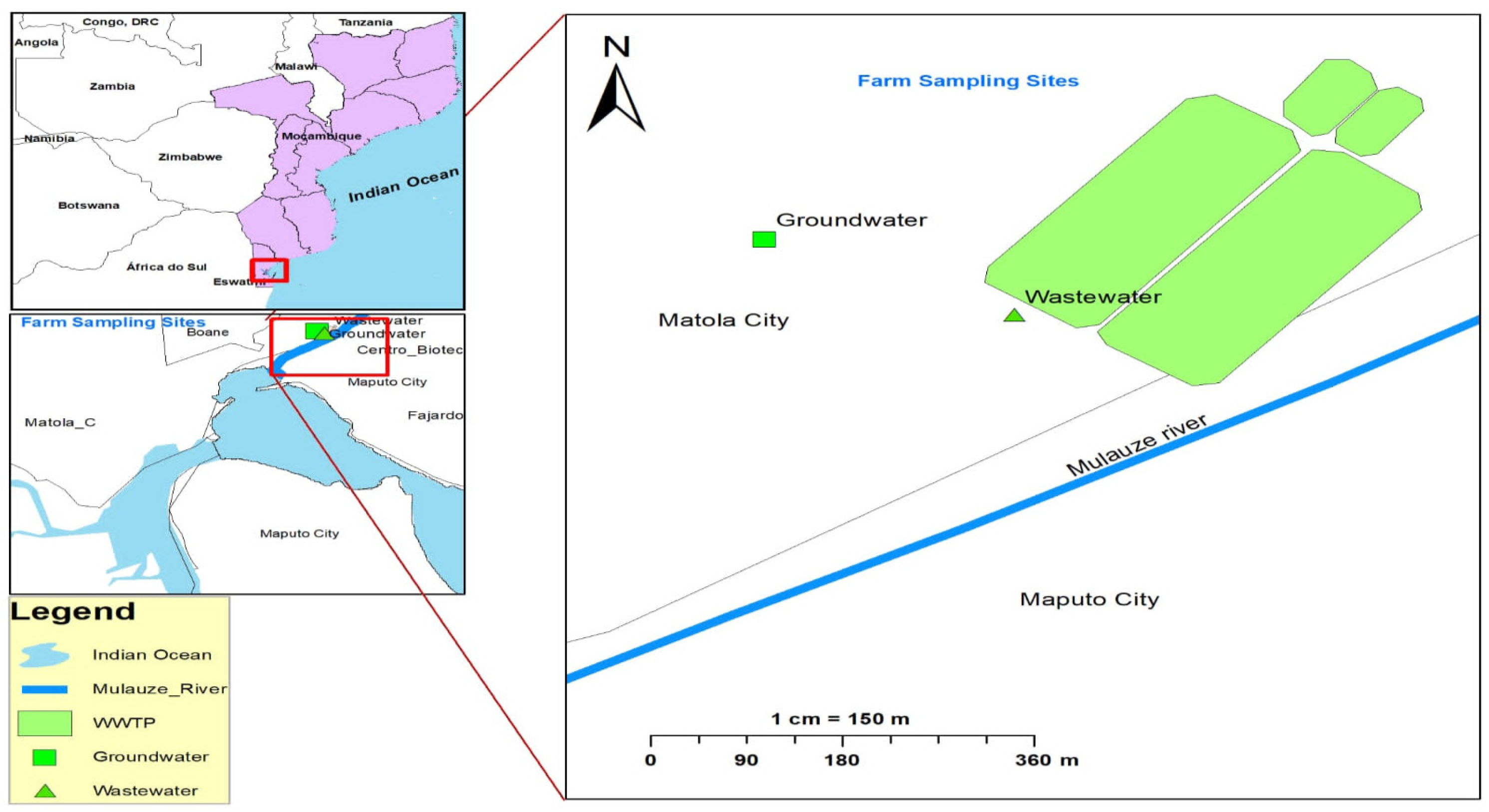
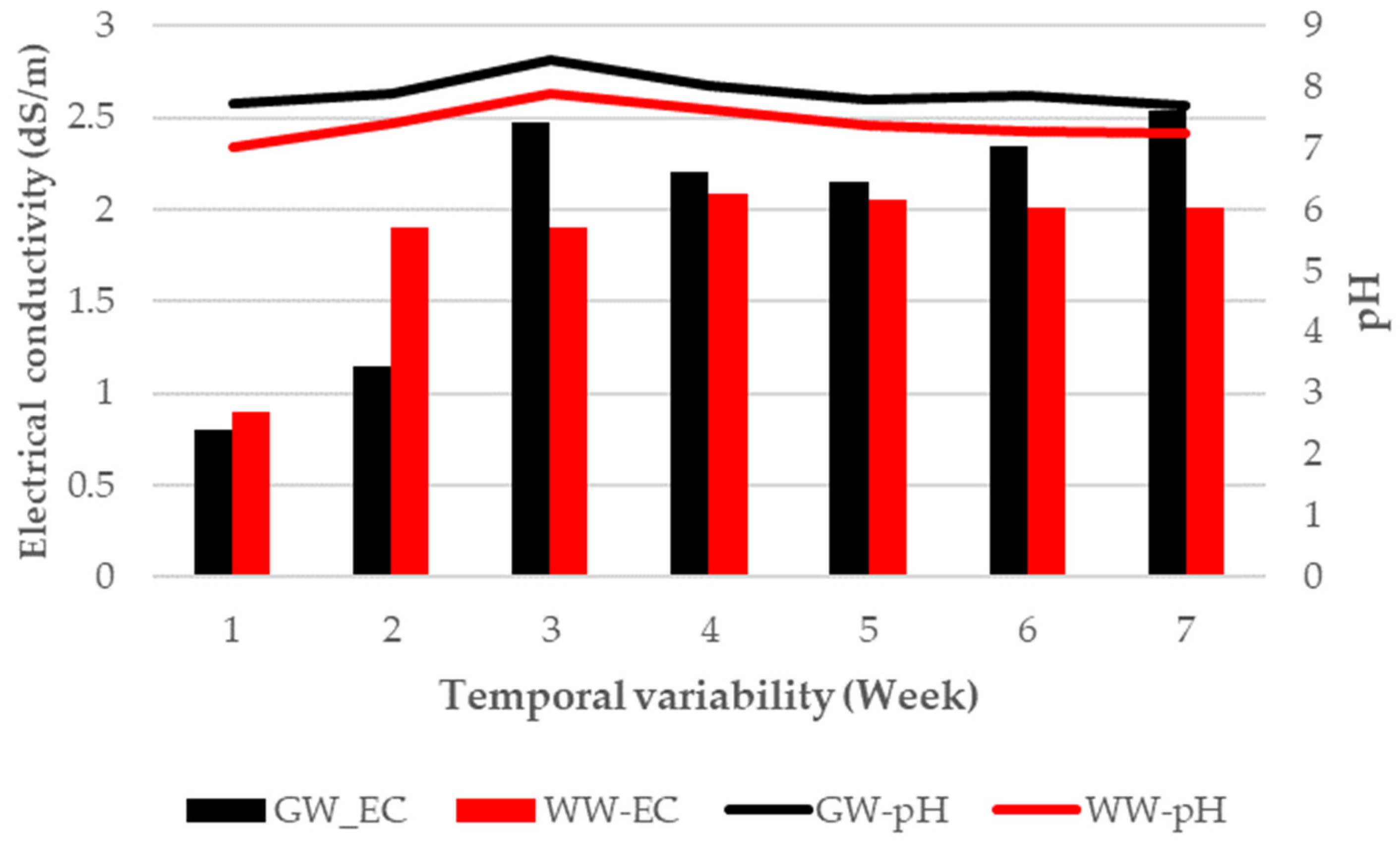

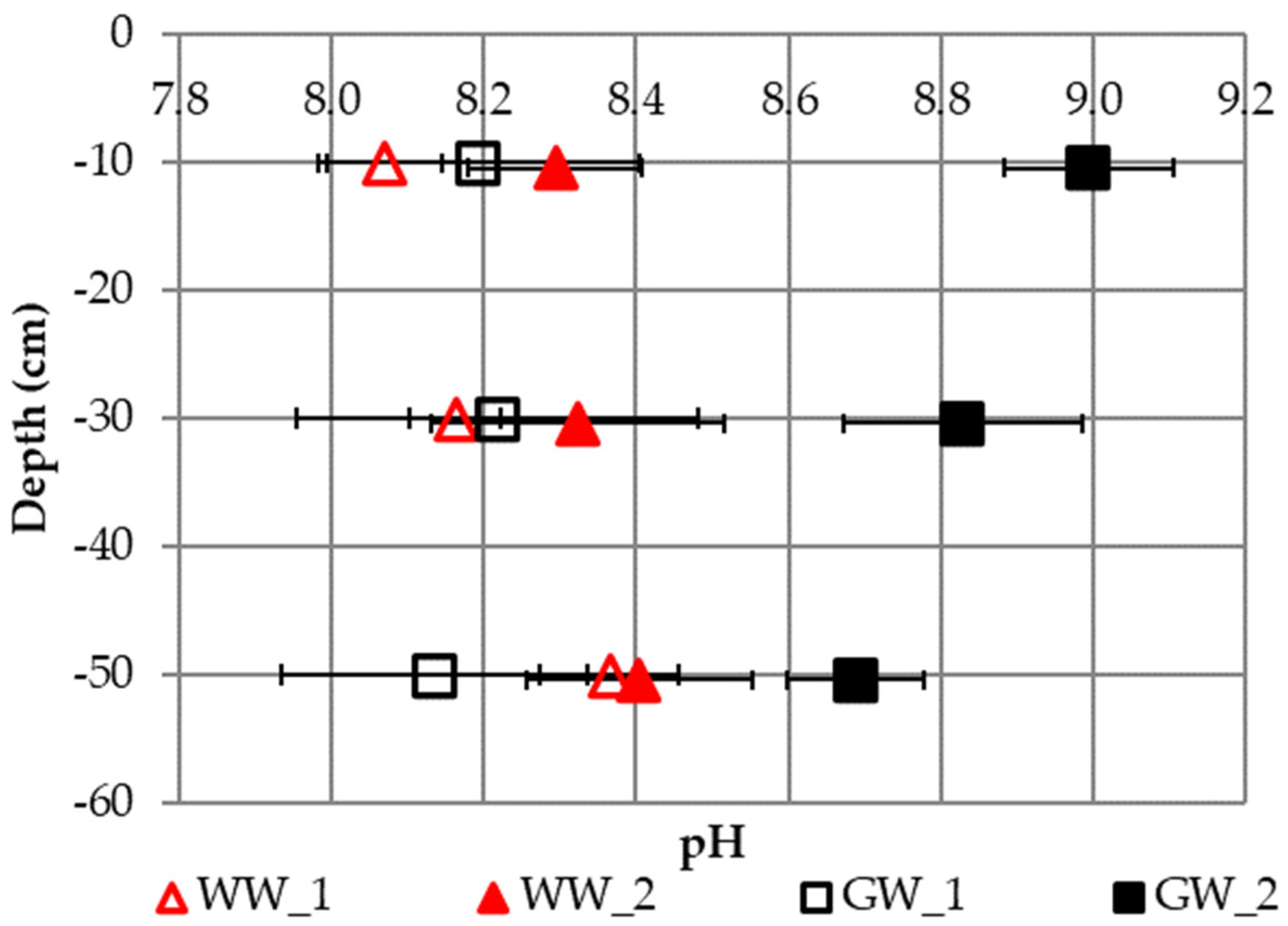

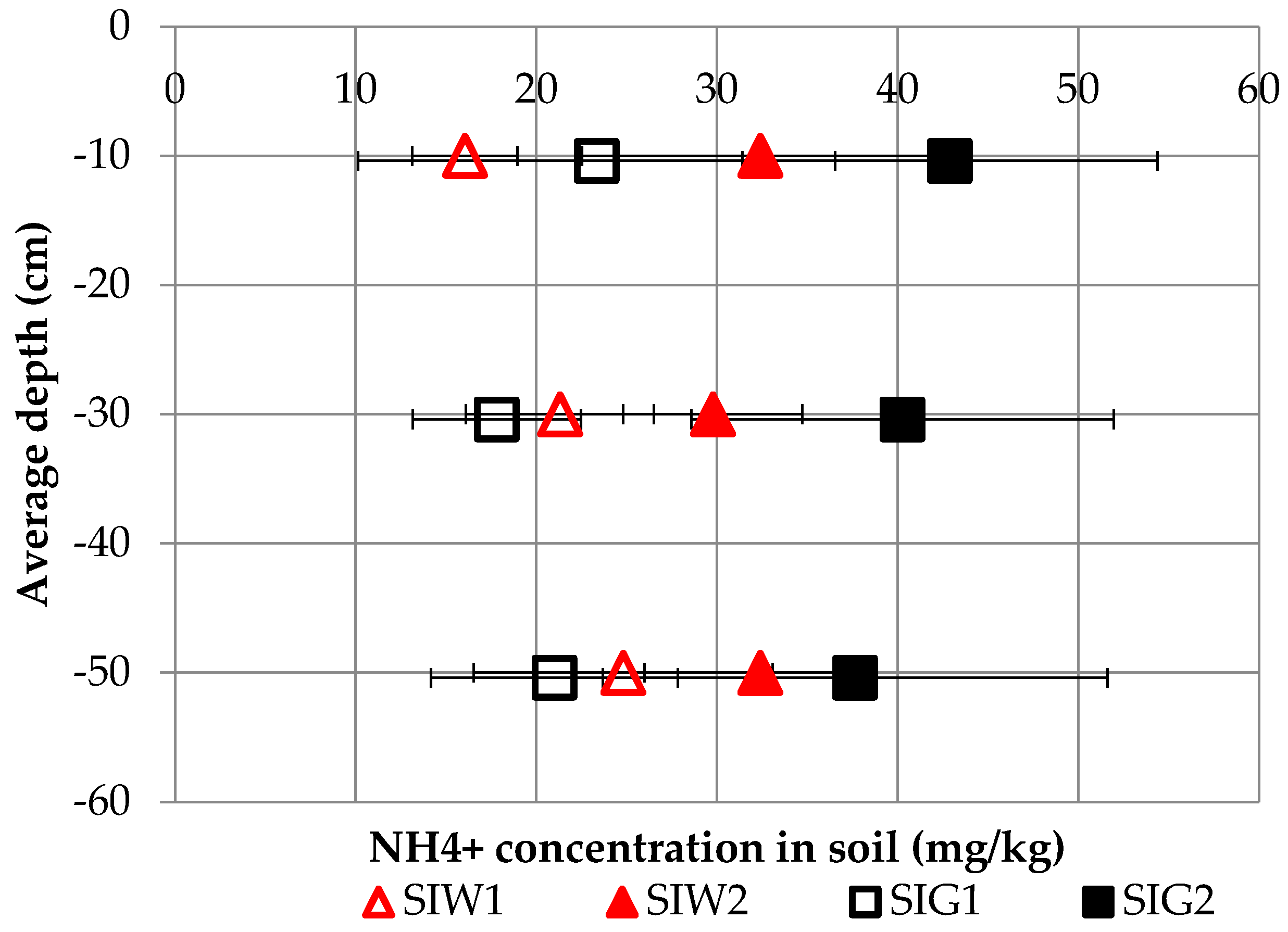




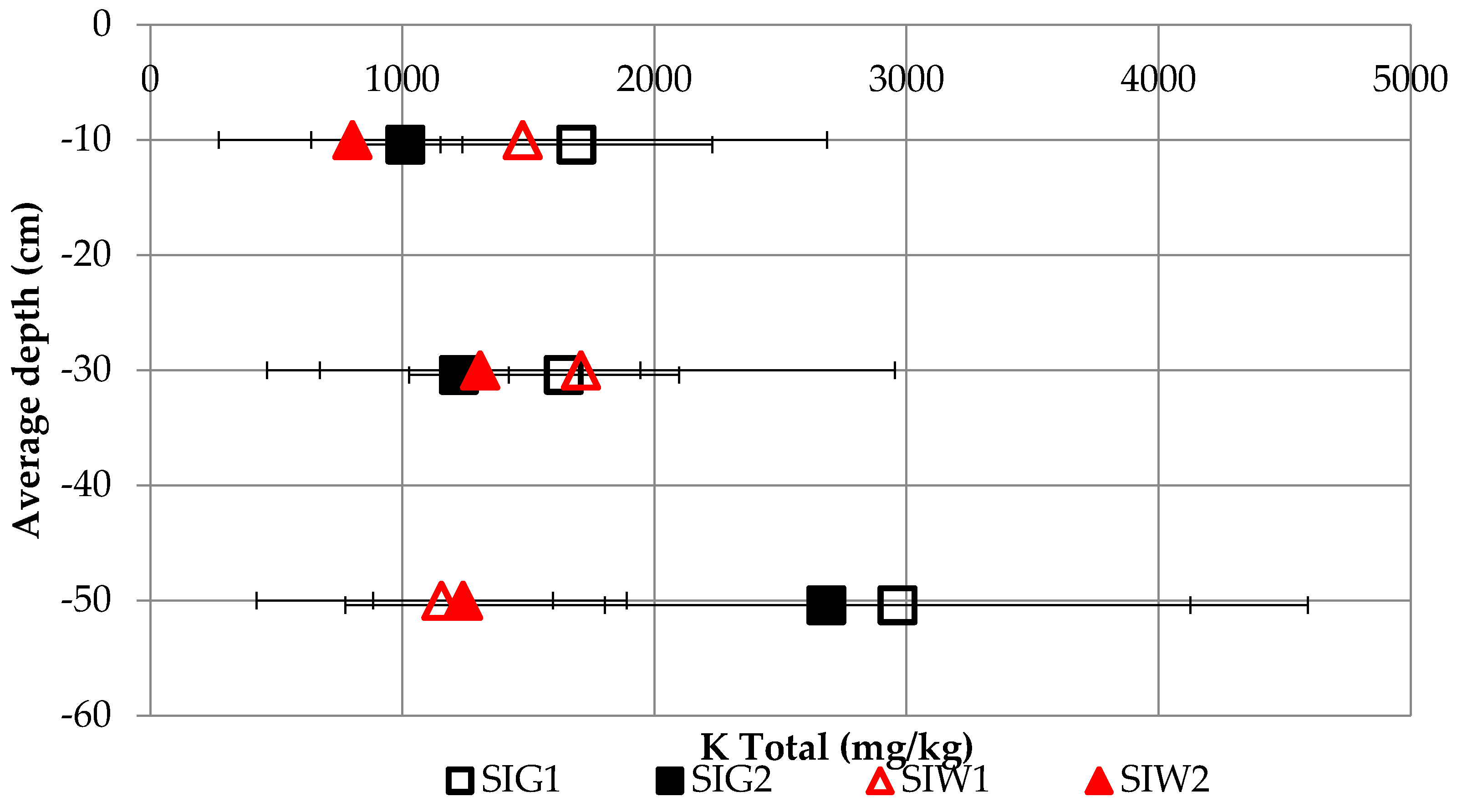
| Nutrient Forms | Soil | Plants and Manure | Water |
|---|---|---|---|
| Total N | Kjeldahl method [34,35,36] | Kjeldahl method [34,35,36] | Hach test kits (TNT 828) detection limit detection 20–100 mg/L( HACH LANGE GMBH, Düsseldorf, Germany) |
| Extraction KCl (Minema Chemicals, Johanesburg, South Africa)and distillation and titration [36] | Hach LCK 339 (0.23–13.5 mg/L NO3-N/1–60 mg/L NO3) ( HACH LANGE GMBH, Düsseldorf, Germany) | ||
| Extraction KCl (Minema Chemicals, Johanesburg, South Africa )and distillation and titration [36] | Hach LCK 303 (2–47 mg/L NH4-N or 2.5–60 mg/L NH4) ( HACH LANGE GMBH, Düsseldorf, Germany) | ||
| Total P | Spectrophotometer (digested with H2SO4 and salicylic acid, selenium, and hydrogen peroxide) supplied by Minema Chemicals, Johannesburg, South Africa) [34,35,36] | Spectrophotometer (digested with H2SO4 and salicylic acid, selenium, and hydrogen peroxide) supplied by Minema Chemicals, Johannesburg, South Africa [34,35,36] | |
| Olsen [37] | - | Hach TNT 845 (2–20 mg/L PO4-P or 6–60 mg/L PO4) (HACH LANGE GMBH, Düsseldorf, Germany) | |
| Total K | Flame photometric method (digested with H2SO4 and salicylic acid, selenium, and hydrogen peroxide) supplied by Minema Chemicals, Johanesburg, South Africa [34,35,36] | Flame photometric method (digested with H2SO4 and salicylic acid, selenium, and hydrogen peroxide supplied by Minema Chemicals, Johannesburg, South Africa) [34,35,36] | |
| Available K+ | Flame photometric method (Extraction method using ammonium acetate (Minema Chemicals, Johanesburg, South Africa) [36,38] | Hach LCK 328 (8–50 mg/L K+) ( HACH LANGE GMBH, Düsseldorf, Germany) |
| Parameter | Water Source | |
|---|---|---|
| Groundwater | Wastewater | |
| (mg/L) | 3.5 ± 5.3 * | 0.9 ± 0.2 |
| (mg/L) | 0.1 ± 0.1 | 0.4 ± 0.4 |
| (mg/L) | 0.1 ± 0.2 | 231.8 ± 150 |
| Total N (mg/L) | 16.4 ± 19.1 | 461.6 ± 279.5 |
| K+ (mg/L) | 31.8 ± 5 | 405.9 ± 130 |
| (mg/L) | 6.0 ± 2.9 | 81.1 ± 46.5 |
| pH | 7.92 ± 0.25 | 7.40 ± 0.29 |
| EC (dS/m) | 1.95 ± 0.69 | 1.84 ± 0.42 |
| Depth (cm) | Soil Irrigated Wastewater (SIW) | Soil Irrigated Groundwater (SIG) | ||||
|---|---|---|---|---|---|---|
| Clay (%) | Silt (%) | Sand (%) | Clay (%) | Silt (%) | Sand (%) | |
| 0–20 | 16.3 ± 4.3 | 4.8 ± 3.0 | 78.9 ± 3.8 | 13.9 ± 4.3 | 6.3 ± 2.6 | 79.7 ± 4.7 |
| 20–40 | 21.8 ± 10.2 | 6.7 ± 3.1 | 71.5 ± 9.4 | 15.1 ± 2.1 | 6.5 ± 2.8 | 78.4 ± 2.8 |
| 40–60 | 17.5 ± 3.2 | 11.7 ± 3.2 | 70.9 ± 9.7 | 29.8 ± 17.9 | 12.2 ± 8.9 | 57.9 ± 23.3 |
| Irrigation Source | Depth (cm) | % of OM Content | CEC (meq/100 g) | ||||
|---|---|---|---|---|---|---|---|
| Before Planting | After Harvest | p Values (BP × AH) | Before Planting | After Harvest | p Values (BP × AH) | ||
| WW | 0–20 | 0.8 ± 0.4 | 0.7 ± 0.2 | 0.82 | 7.5 ± 1.6 | 6.2 ± 1.3 | 0.01 |
| 20–40 | 0.6 ± 0.3 | 0.8 ± 0.8 | 0.45 | 9.7 ± 3 | 7.6 ± 2.6 | 0.01 | |
| 40–60 | 0.8 ± 0.3 | 0.9 ± 0.9 | 0.68 | 8.6 ± 3.3 | 7.4 ± 1.7 | 0.22 | |
| GW | 0–20 | 1.9 ± 0.3 | 2.3 ± 0.3 | 0.08 | 10.9 ± 1.2 | 10.7 ± 3.5 | 0.88 |
| 20–40 | 1.5 ± 0.4 | 2.1 ± 0.4 | 0.02 | 12.1 ± 1.7 | 12.4 ± 1.5 | 0.47 | |
| 40–60 | 2.1 ± 0.9 | 2.0 ± 0.5 | 0.66 | 19.0 ± 11.4 | 20.7 ± 11.7 | 0.28 | |
| p values (SIW × SIG) | |||||||
| 0–20 | <0.00 | <0.00 | <0.00 | 0.00 | |||
| 20–40 | <0.00 | <0.00 | 0.07 | <0.00 | |||
| 40–60 | <0.00 | 0.01 | 0.37 | 0.02 | |||
| Irrigation Source | N_Inflow (kg/ha) | N_Uptake (kg/ha) | Ratio | Balance (kg/ha) | |
|---|---|---|---|---|---|
| Water | Manure | ||||
| GW | 151.5 | 497 | 1973.6 | 0.3 | −1324.4 |
| WW | 5086.0 | 714.1 | 2571.2 | 2.3 | 3229.6 |
| P_Inflow (kg/ha) | P_Uptake (kg/ha) | Ratio | Balance (kg/ha) | ||
| Water | Manure | ||||
| GW | 64.9 | 20.7 | 66.2 | 1.3 | 19.4 |
| WW | 981.6 | 43 | 90.0 | 11.4 | 934.6 |
| K_Inflow (kg/ha) | K_Uptake (kg/ha) | Ratio | Balance (kg/ha) | ||
| Water | Manure | ||||
| GW | 342.6 | 113.2 | 970.9 | 0.5 | −515.1 |
| WW | 4910.6 | 163.2 | 1038.7 | 4.9 | 4035.1 |
Disclaimer/Publisher’s Note: The statements, opinions and data contained in all publications are solely those of the individual author(s) and contributor(s) and not of MDPI and/or the editor(s). MDPI and/or the editor(s) disclaim responsibility for any injury to people or property resulting from any ideas, methods, instructions or products referred to in the content. |
© 2023 by the authors. Licensee MDPI, Basel, Switzerland. This article is an open access article distributed under the terms and conditions of the Creative Commons Attribution (CC BY) license (https://creativecommons.org/licenses/by/4.0/).
Share and Cite
Niquice-Janeiro, C.A.; Arsénio, A.M.; van Lier, J.B. Wastewater-Based Nutrient Supply for Lettuce Production in the Infulene Valley, Maputo, Mozambique. Agriculture 2023, 13, 2158. https://doi.org/10.3390/agriculture13112158
Niquice-Janeiro CA, Arsénio AM, van Lier JB. Wastewater-Based Nutrient Supply for Lettuce Production in the Infulene Valley, Maputo, Mozambique. Agriculture. 2023; 13(11):2158. https://doi.org/10.3390/agriculture13112158
Chicago/Turabian StyleNiquice-Janeiro, Celma Almerinda, Andre Marques Arsénio, and Jules Bernardus van Lier. 2023. "Wastewater-Based Nutrient Supply for Lettuce Production in the Infulene Valley, Maputo, Mozambique" Agriculture 13, no. 11: 2158. https://doi.org/10.3390/agriculture13112158
APA StyleNiquice-Janeiro, C. A., Arsénio, A. M., & van Lier, J. B. (2023). Wastewater-Based Nutrient Supply for Lettuce Production in the Infulene Valley, Maputo, Mozambique. Agriculture, 13(11), 2158. https://doi.org/10.3390/agriculture13112158








